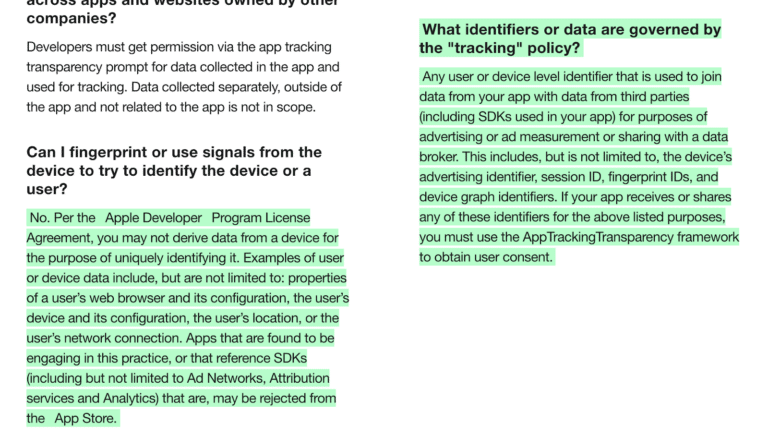If you’re reading this, you likely already know that Apple recently announced that all apps must gain consent for ad tracking via their new App Tracking Transparency (ATT) framework only. If the user does not opt in via this method, Apple has ruled that SKAdNetwork will be the only acceptable alternative for ad tracking. These changes are likely to come into effect with the release of iOS 14.5 this spring.
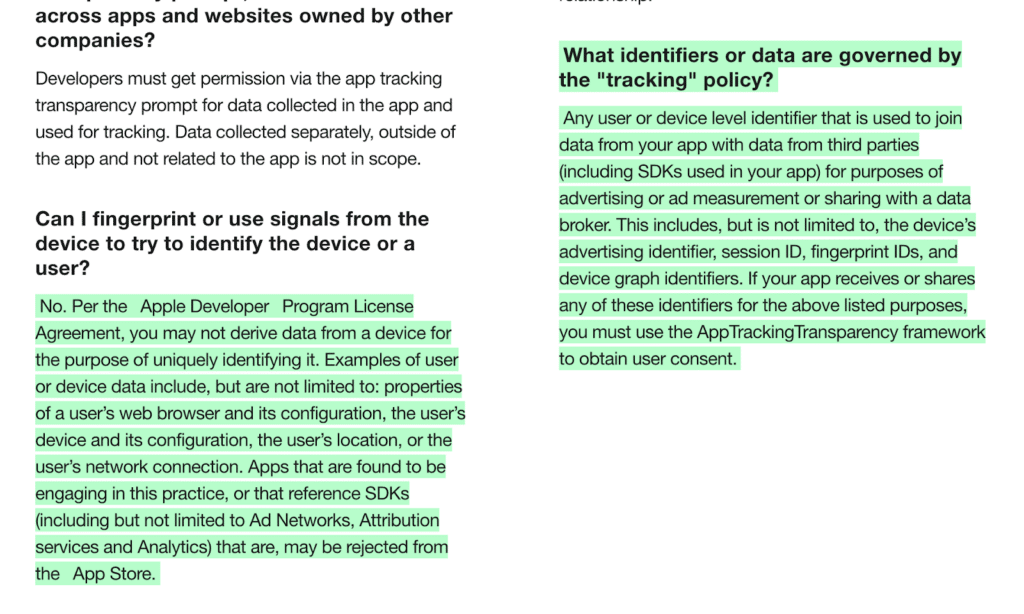
Apple’s new changes highlighted.
This leaves two choices for brands:
- Attempt to gain user opt-in via the AppTrackingTransparency framework
This grants possible access to granular ad attribution data on iOS, and all the benefits that come with it.
OR - Live with aggregate data only
As provided by Apple’s SKAdNetwork only.
Clearly, it’s in brands’ best interest for users to opt in. Doing so will preserve granular data like the IDFA that allows you to better understand user journeys, better understand your campaign performance, serve more relevant ads, and keep your app free for users.
We’ve compiled a guide to help you optimize the chances of user opt in, with some tips from brands currently testing and succeeding with these practices.
1. Test a prompt that provides context to Apple’s modal
We recommend that you test a prompt that provides users information on why you’re asking for their data before they see Apple’s ATT modal. By creating a context-providing prompt, you can control the language and messaging, placement, and design to optimize the chances of user opt-in to ATT. This is key to fully explain to users the benefits they gain from opting in, explain what you are asking them for, address privacy concerns, and prime them to take action.
In the image below, a fictional gaming app shows their own modal that provides context to Apple’s ATT modal. The brand explains why they are asking users to opt in, and demonstrates the value users receive from opting in, such as keeping the app free and improving the user’s ads experience. By taking the time to explain why they are asking for users’ data, the gaming app puts users’ minds at ease and prepares them to click “Allow” on the next screen.
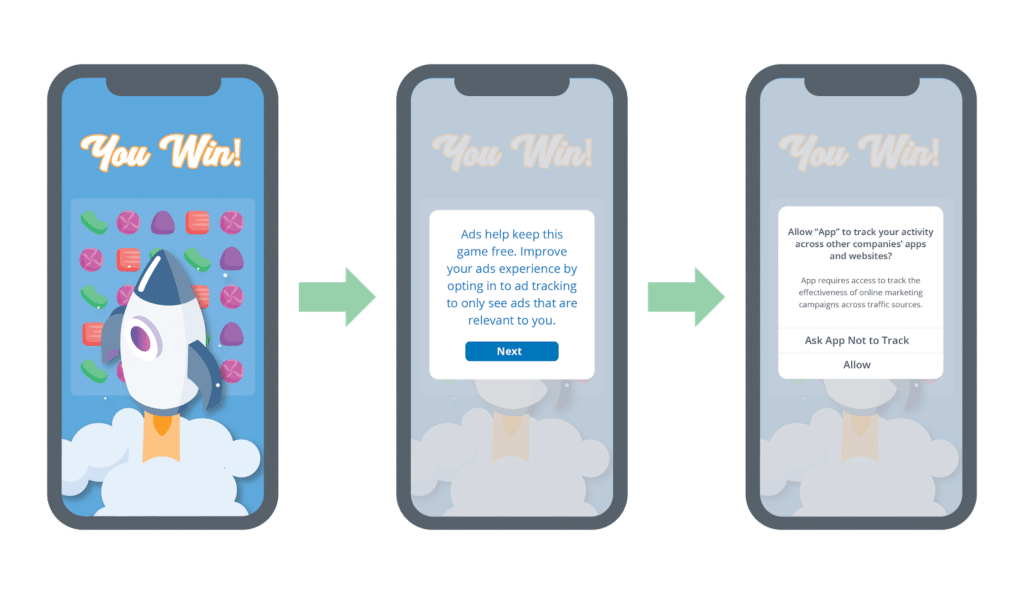
It’s important to note that Apple is cracking down on showing your own pre-permission prompts that require users to opt in to an additional modal outside of the ATT modal:
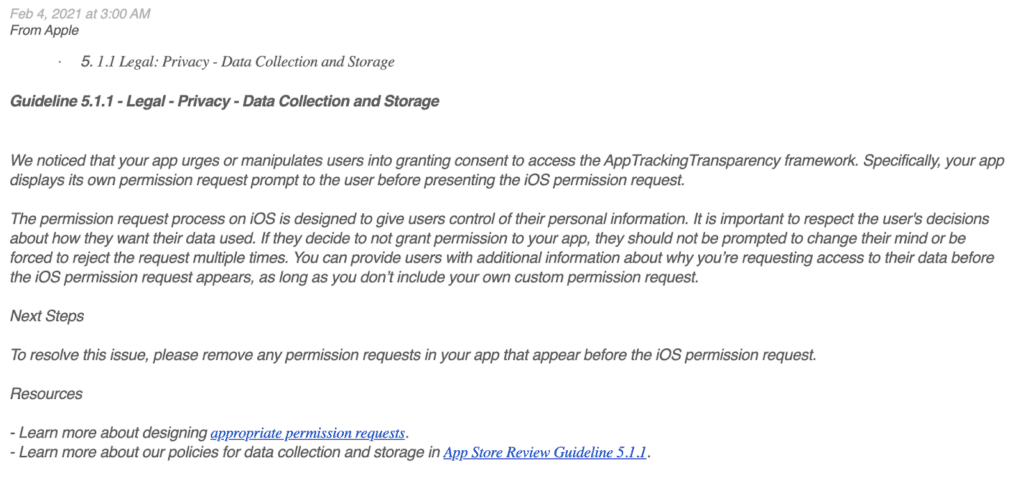
For example, you wouldn’t be allowed to show your users this prompt, because it asks users to opt in via a mechanism other than the ATT framework:
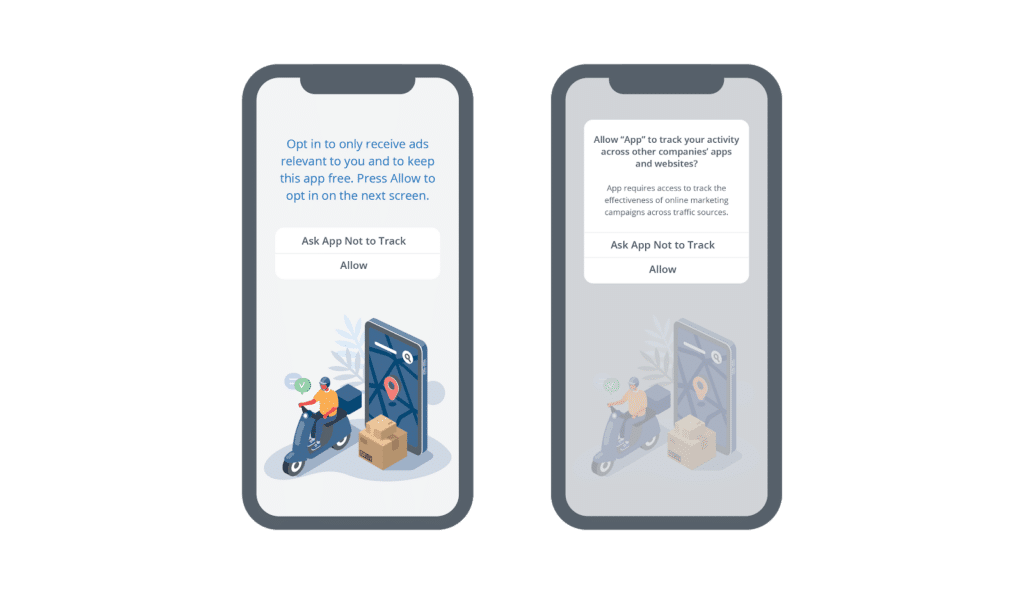
Take caution with the language in your prompt by refraining from asking users to opt in via your own framework. Rather, use your prompt to give context about Apple’s ATT modal, and use call to action buttons such as “Proceed” or “Next” or “Continue” rather than “Allow” to take users to the ATT modal.
2. Explain the value proposition of opting in
Users likely won’t willingly share their data with you unless they receive some tangible benefit. Show users why opting in brings them value by explaining how their data will be used and how opting in improves their experience. This could be through:
- Monetary benefits – Remind users that by opting in, they’re keeping your app free for them to use. “Opting in keeps this ad free for you to use.”
- Personalization – Explain how opting in gets rid of content users don’t care about. “Opt in to get rid of ads not relevant to you.” “Opt in now to only see ads relevant to you.”
- Rewards – Apple’s policies state that direct compensation is not allowed, but many have interpreted this to mean that non-monetary rewards are allowed as long as all users can access them (you couldn’t give coins to only those users who opt in, but you could give extra coins to those that do). If you can, reward opt-ins with bonuses like extra points, extra ad skips, or in-game coins: “Opt in to receive 100 bonus coins.” Again, this is likely permitted, but Apple’s language isn’t clear enough to say so with 100% certainty (we’re hoping they clear that up soon).
- Assuaging privacy concerns – Include why and how users’ data is used, and ensure them that their data is in safe hands. “We use your data to serve you more relevant ads and to help keep this app free. We never rent or sell your data.”
- Urgency + FOMO-Inducing Language – Emphasize the importance and timeliness of opting in now rather than waiting. “Opt in now to stop seeing irrelevant ads.” “Allow tracking now to ensure you never see irrelevant ads.” “Allow tracking so you don’t see irrelevant ads later.”
- Positive framing – Use positive language to frame your permission question. “I want to see only the ads most relevant to me.” “Show only the ads most relevant to me.”
When a user can see how sharing their data will benefit them personally, you’re more likely to get their informed consent.
3. Optimize the timing of your ask
Getting the timing right to ask users the big question is critical. It might not be the most optimal to ask users to opt in the moment they open your app or sign up, for example (although you should test to find out). There are likely steps in your user flow where it makes more sense to place Apple’s modal and your context-providing modal, such as after a purchase, time frame, or other event or trigger.
We recommend placing both your context-providing modal and the Apple ATT modal where users are most primed to give consent. This could be after moments after achievement, such as completing a game, after they spend a certain amount of time in the app, or after onboarding. Don’t show the modal when users are in the middle of completing a task, such as playing a game or filling in a form. Interrupting users in high-stakes moments is more likely to lead to frustration and drop off than opt-in.
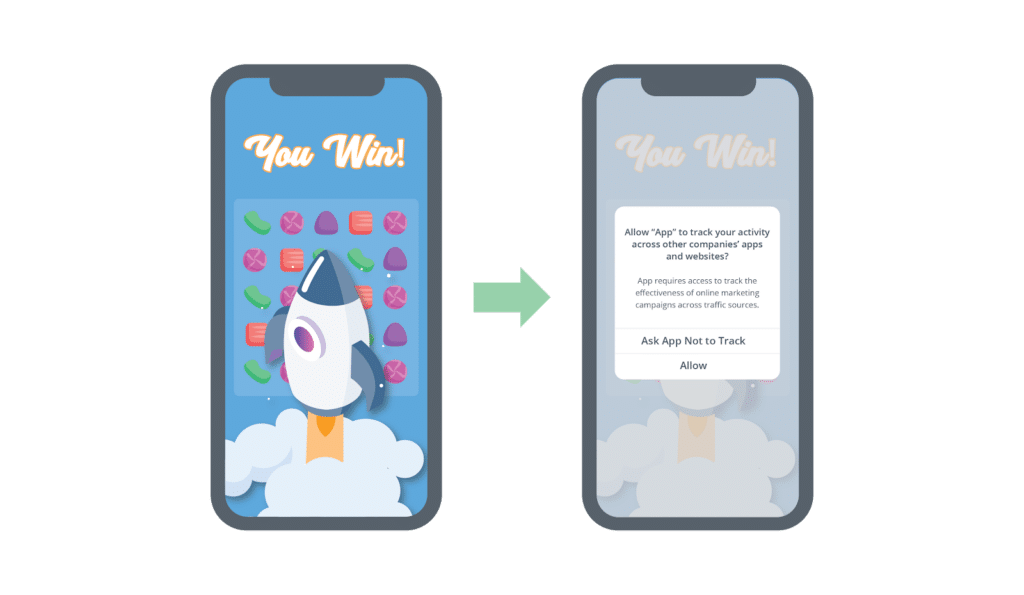
Show users your modal after the user successfully completes an action that ties into the value of your app.
4. Make opting in as easy as possible
If you choose to show your context-providing modal to users before Apple’s modal, mitigate confusion by telling users what to expect when going through the permission flow. Clarify that users will be taken through two prompts and clarify where users will be giving consent. This could look like:
- Show first modal (contextual modal): “Opt in to only receive ads relevant to you and to keep this app free. Press Proceed to opt in on the next screen.”
- Show second modal (Apple modal)
Or
- Show first modal (contextual modal): “Opt in to only receive ads relevant to you and to keep this app free. Press Next, then grant permission via the popup.”
- Show second modal (Apple modal)
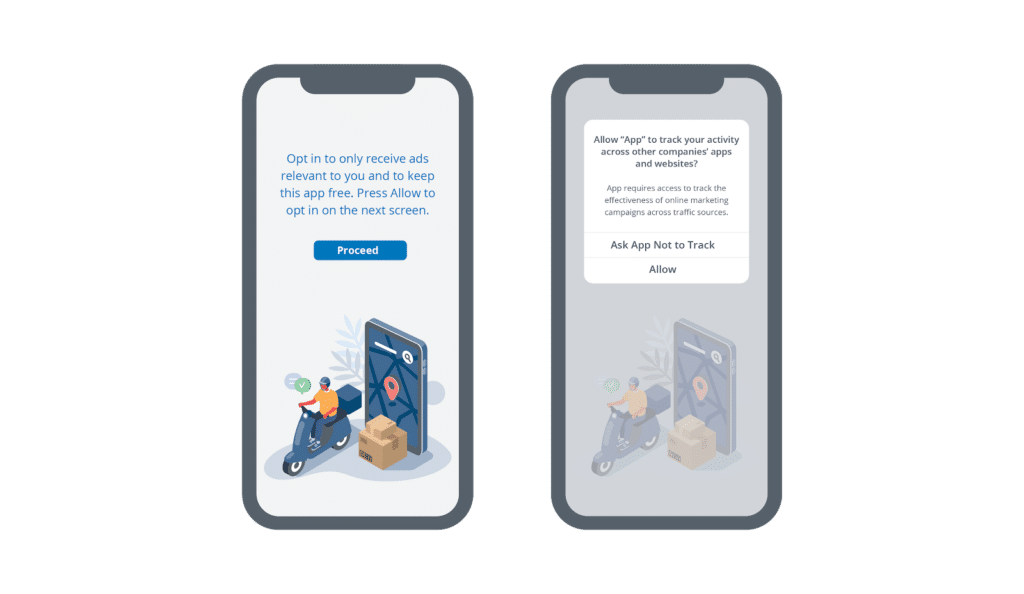
Walk users through the permission flow, explaining where and when to take action.
5. Test Grouping with Other Privacy Permissions
If you have other privacy permissions you need to gain user consent for, test grouping Apple’s permission prompt with those notices to see if they result in higher rates of opt in. However, ensure you are GDPR compliant — you cannot pre-select opt-in checkboxes for users, for example.
6. Continuously A/B Test
Rigorously A/B test the effectiveness of your modal(s) with a smaller number of users before launching at full scale. Separate testing by user segments to discover if certain ones are more likely to opt in. Group by characteristics such as spending X amount of time in the app, prior data consent behavior, purchase amount, etc. Test the effectiveness of your context-providing modal vs. showing the Apple modal only, as well as the timing and placement of when both modals are shown (after or before a certain event, or after a certain time.). After determining the opt-in rates achieved by testing these key variables, you should also test:
- Copy and language: Do certain words or phrases lead to higher or lower opt-in rates?
- Design: Do certain colors or designs lend themselves to higher opt-in rates?
- Size: Does showing a full-screen or smaller-screen version of your modal make a difference?
The time is now to start testing various methods of obtaining user opt in. By building trust, showing value, and explaining to users how providing their data enables them to have a better in-app experience, the more likely they are to opt in.
For more information on Apple’s latest attribution policy on iOS 14, read our latest blog post and reference our iOS 14 resource hub. Register for our webinar (held at both North America/AUS and EMEA times) to discover more about how this change impacts mobile advertising and what you should do next.






















